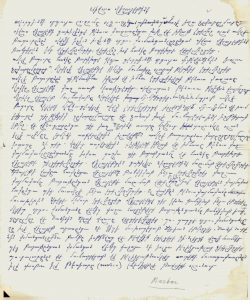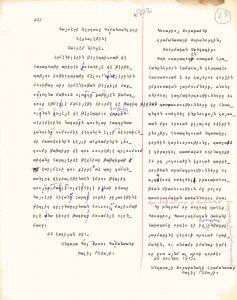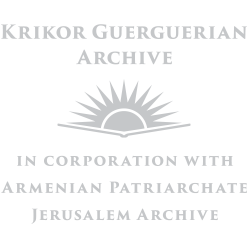The Krikor Guerguerian Archive, which was prepared by Guerguerian as an effort to lay the groundwork for scientific research on the 1915 Armenian Genocide, contains a generous number of rich Armenian sources. These materials, however, are strewn across various different folders and files and are not systematically catalogued whatsoever. Therefore, despite is richness and variety, this Archive is fairly difficult to navigate.
It is possible to divide the Armenian sources of the Archive into two separate categories: Armenian texts and Ottoman texts written in the Armenian alphabet.

The Armenian texts consists of materials such those from the Armenian Patriarchate in Istanbul; the documents gathered and collected by Aram Andonian; the works and/or testimonies of persons such as Teotik; the translations of Ottoman documents; and a collection of clippings from various newspapers.
When Patriarch Zaven, who was the Armenian Patriarch of Istanbul between 1913-1922, left Istanbul, he took the Patriarchate’s archive with him, first to Marseille and later to Jerusalem. Upon examination of the Armenian materials in Guerguerian’s Archive, it becomes clear that Guerguerian had traveled to Jerusalem, found these documents and made copies of them. Guerguerian further enriched his archive by also copying a number of documents that belonged to the Istanbul Patriarchate and were being kept in the Nubarian Library in Paris.
These two factors are what render this archive crucial and unparalleled. For no historian working on the genocide ever had the chance to see these documents all together.
Another group of sources that is of equal importance, are the Armenian materials collected (mostly) by Aram Andonian and kept in the Paris Nubarian Library. The invaluable nature of these materials, based primarily on the first-hand accounts of genocide survivors from 1917-19, cannot be underscored enough.
Krikor Guerguerian translated the Ottoman documents found in his Archive into Armenian, either directly himself or with the aid of translators. In some cases, instead of translating them directly into Armenian, he was contented with simply rewriting the Ottoman texts in the Armenian alphabet. Therefore, it is possible to find the same document in two different versions – translated into Armenian and rewritten in the Armenian alphabet.
In terms of first-hand accounts of the genocide, the testimonies of survivors are not the only thing the Archive has to offer. Namely, it also contains the original hand-written copies of the classic first works of intellectuals such as Aram Andonian, Yervant Odian and Teodik on the Armenian Genocide.

Additionally, articles and essays written in Armenian by Guerguerian himself can also be found in the Archive. These works encompass and stretch over a very large time frame. The various aspects of the period leading up to the genocide, between 1878-1915; the issue of Abandoned Properties; the Istanbul Military Tribunals; and the Armenian Republic established in 1918 are just some examples of these works. There are also materials concerning the topics of Armenia joining the Soviet Union and the issue of Karabagh.
The Archive contains several unpublished essays by Guerguerian, as well, the most important of which is undoubtedly his work on the genocide in Kayseri. This crucial text was almost finished, yet remains unpublished for unknown reasons. Lastly, the Archive also includes various materials providing the ethnography and folkloric traditions of Western Armenians.
It is unnecessary to state further the extent to which these abovelisted materials represent an irreplaceable treasure cove for scholars of Armenian history and the Armenian Genocide.
